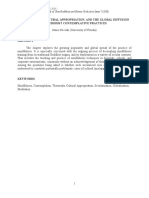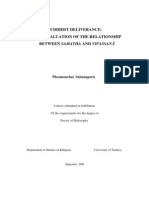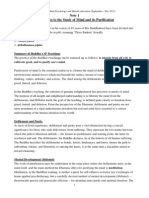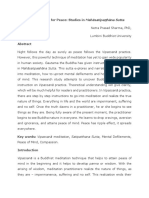0 ratings0% found this document useful (0 votes)
23 viewsA Satitherapy Session
A Satitherapy Session
Uploaded by
Matt AldridgeCopyright:
© All Rights Reserved
Available Formats
Download as PDF, TXT or read online from Scribd
A Satitherapy Session
A Satitherapy Session
Uploaded by
Matt Aldridge0 ratings0% found this document useful (0 votes)
23 views3 pagesCopyright
© © All Rights Reserved
Available Formats
PDF, TXT or read online from Scribd
Share this document
Did you find this document useful?
Is this content inappropriate?
Copyright:
© All Rights Reserved
Available Formats
Download as PDF, TXT or read online from Scribd
Download as pdf or txt
0 ratings0% found this document useful (0 votes)
23 views3 pagesA Satitherapy Session
A Satitherapy Session
Uploaded by
Matt AldridgeCopyright:
© All Rights Reserved
Available Formats
Download as PDF, TXT or read online from Scribd
Download as pdf or txt
You are on page 1of 3
A SATITHERAPY SESSION
DEPICTED IN BRIEF
This text is not meant for Western psychologists and
psychotherapists!
The text is being used as a handout in seminars for Buddhist
monks and upasakas who undergo a basic training to assist the
satitherapists. It is not expected that these monks have any
knowledge of Western psychology, however they know well all the
Pali terms used in the text and thus need no explanation of them.
For more information see: www.volny.cz/satiterapie
Definition. Satitherapy is a system of integrative psychotherapy which uses
mindfulness (sati) as the key principle within a person–centered approach as
developed by Carl R. Rogers. It integrates the techniques of psychodrama
developed by Jacob L. Moreno for therapeutic acting–out with the procedures
of Buddhist insight meditation (satipatthāna–vipassanā) for therapeutic
acting–in. In the training of satitherapists, the conceptual frame of Western
mainstream psychology is used (cf. the article on Mindfulness in Corsini,
R.J. (Ed.): Encyclopedia of Psychology, New York, Wiley 1994), yet the
theoretical basis for satitherapy is provided by the system of psychology and
ethics elaborated within the ancient Asian teachings of Abhidhamma (Frýba,
M.: The Art of Happiness – The Teachings of Buddhist Psychology, Boston,
Shambhala Publications 1989).
Format and Process. The working place (kammatthāna) of satitherapy is
governed by the Abhidhamma principles (summed up in the
patibhānapatisambhide ñānam, literally: “knowledge when to apply what
type of distinctions”) which are scientifically verified. The process
(patipadā) of each satitherapy session is borne by the three pivotal requisites:
1) The protected space (sīma) which is free from the consequences of
eventual failures while exploring psychotope and trying out even
seemingly risky new ways of coping.
2) The supportive relationship (kalyāna–mittatā) with the therapist
which gives guidance and security.
3) The satitherapeutic repertory of skills (upāya–kosalla,
indriyaparopariyatte–ñānam, etc.).
All requisites of satitherapy are applied in accordance with the actually
arising needs to create (vatta) or remove (pativatta) the specific conditions
(paccaya) for cure.
In each satitherapy session – whether performed as group or individual
treatment – the following seven steps of creating and removing (vatta–
pativatta) are always distinguished:
1) Establishing the protected space (sīma): this includes rituals, such as
the Buddhist taking of Triple Refuge, or Christian prayer, etc.)
2) General exploration of psychotope (tiloka–vavatthāna), i.e. of the
patients’ present state of mind, family situation, frame of living…
3) Rejoicing about the patient’s assets (āya–kosalla), life skills, good
habits, meritorious deeds (puñña) – this strengthens the patient’s mind
basis for the subsequent coping with problems.
4) Compassionate understanding through an extensive listening
(mahā–karunā–ñānam) to the patient’s problems (apāya–kosalla).
5) Assisting patients in finding their own ways and means (upāya–
kosalla) for the problem’s solution.
6) Reviewing (paccavekkhanā) the whole session without praising or
blaming.
7) Methodical ending of the session, sharing the merit (puñña) of the
work done, further life-style decision (sankappa), ethical precepts
(pañca–sīla), leaving the working place through a ritual transition to the
realm of everyday life.
IMPORTANT – to prevent frequently made misinterpretations:
Satitherapy is a healing treatment. It is a methodical cure of psychological,
social, and spiritual problems. The goals of its procedure are defined by the
patients (not by the therapists!). The therapist is just a specialist chartered to
accompany the patient in the healing process.
Satitherapy is not a religious performance. Satitherapy may use the
patient’s religious sentiments without any coercive persuasion or missionary
influencing. The religious issues are subject to the patient’s own decision.
Satitherapy is a method, which is as easy to learn as e.g. piloting an aircraft
or dental surgery. Any intelligent person, who has already studied the
Abhidhamma and Western clinical psychology, can be trained as a
satitherapist in a course of eight semesters. Satitherapists working with
Buddhist clients and patients can be usefully assisted by Buddhist monks and
laymen trained in the practice (and not simply the ritual chanting!) of the
fourteen skills of Buddha–ñāna.
For further information contact: Venerable Bhikkhu Āyu Kusalānanda
Āyukusala Central European Sangha – ACES
e–mail: ayukusala@web.de or ayukusala@hotmail.com
[ back ]
Copyright © 2002 ACES, all rights reserved.
You might also like
- Ethical Guidelines For Ontario School Counsellors PDFDocument2 pagesEthical Guidelines For Ontario School Counsellors PDFPaul0% (3)
- Mindfulness: A Practical Guide to AwakeningFrom EverandMindfulness: A Practical Guide to AwakeningRating: 4.5 out of 5 stars4.5/5 (16)
- A Discipline of Inquisitiveness: The Body-Speech-Mind Approach To Contemplative SupervisionDocument20 pagesA Discipline of Inquisitiveness: The Body-Speech-Mind Approach To Contemplative SupervisionRobert Walker100% (1)
- The Philosophy of Science - A Very Short Introduction PDFDocument1 pageThe Philosophy of Science - A Very Short Introduction PDFMatt Aldridge0% (3)
- The Christian DISC New-User-Guide-2020Document19 pagesThe Christian DISC New-User-Guide-2020Level Up ConsultingNo ratings yet
- An Explanation of The Yuthok Nyingthig Samaya or Vows ChapterDocument7 pagesAn Explanation of The Yuthok Nyingthig Samaya or Vows ChapterAron David100% (1)
- Handbook of Stress and Academic AnxietyDocument423 pagesHandbook of Stress and Academic AnxietyAna Paula C. LucenaNo ratings yet
- VipassanaDocument7 pagesVipassanascribdmisraNo ratings yet
- The Dark Side of DharmaDocument19 pagesThe Dark Side of DharmaSergio ResendeNo ratings yet
- Buddhist PsychotherapyDocument288 pagesBuddhist PsychotherapyUpUl Kumarasinha100% (2)
- The Satipatthana Vipassana Meditation - A Basic Buddhist Mindfulness ExerciseFrom EverandThe Satipatthana Vipassana Meditation - A Basic Buddhist Mindfulness ExerciseNo ratings yet
- Concept and Reality in Early Buddhist Thought PDFDocument176 pagesConcept and Reality in Early Buddhist Thought PDFMatt Aldridge100% (1)
- Education in de Ole Time DaysDocument2 pagesEducation in de Ole Time Dayscurlylocks24No ratings yet
- Behavior Therapy PowerpointDocument49 pagesBehavior Therapy PowerpointAnonymous 91aGcLj100% (2)
- Principles of SatitherapyDocument23 pagesPrinciples of SatitherapyEdvard TamNo ratings yet
- Yoga and Mindfulness Based Cognitive Therapy: A Clinical GuideFrom EverandYoga and Mindfulness Based Cognitive Therapy: A Clinical GuideRating: 4 out of 5 stars4/5 (1)
- Therapeutic Psychology and Indian YogaDocument22 pagesTherapeutic Psychology and Indian YogaJuan Luis Köstner MartinoNo ratings yet
- Buddhist Psychology: - in The View of Educated Westerners and Instructed BuddhistsDocument10 pagesBuddhist Psychology: - in The View of Educated Westerners and Instructed BuddhistsWaiyan HtutNo ratings yet
- Manic Depression or Bipolar Disorder - Integrated Chinese Medicine and AyurvedaDocument32 pagesManic Depression or Bipolar Disorder - Integrated Chinese Medicine and AyurvedaSaraSou100% (1)
- PHD Thesis IonDocument134 pagesPHD Thesis Ionrupalparth49070% (1)
- Zen and Contemporary Knowledge: A Commentary Treatise in Question and Answer FormatFrom EverandZen and Contemporary Knowledge: A Commentary Treatise in Question and Answer FormatNo ratings yet
- Buddhist Psychotherapy H S S Nissanka CompressDocument165 pagesBuddhist Psychotherapy H S S Nissanka CompressCristian Cotarcea50% (2)
- Path To Enlightenment: A Guide To Meditation Techniques Practiced in ThailandDocument65 pagesPath To Enlightenment: A Guide To Meditation Techniques Practiced in ThailandShubham InfinityNo ratings yet
- Kabatzin 2003Document9 pagesKabatzin 2003psalvoNo ratings yet
- Mindfulness Cultural Appropriation and T PDFDocument15 pagesMindfulness Cultural Appropriation and T PDFKellerMirellaNo ratings yet
- 05 Chapter 2Document60 pages05 Chapter 2alokNo ratings yet
- Evo Med Lesson 9 - 2023 (Sik Hinhungs Conflicted Copy 2024Document66 pagesEvo Med Lesson 9 - 2023 (Sik Hinhungs Conflicted Copy 2024Canice ChiuNo ratings yet
- A Buddhist Perspective On Mental Health - Tariki Books and PapersDocument7 pagesA Buddhist Perspective On Mental Health - Tariki Books and PapersfluidmindfulnessNo ratings yet
- Nyanasatta Thera Satipatthana Sutta The Foundations of Mindfulness 1993Document21 pagesNyanasatta Thera Satipatthana Sutta The Foundations of Mindfulness 1993sengcanNo ratings yet
- Buddhist Meditation Theory and Practice in Pāli Canon by NirupamDocument83 pagesBuddhist Meditation Theory and Practice in Pāli Canon by NirupamTeguh KiyatnoNo ratings yet
- Silavanta Sutta - Mahasi SayadawDocument125 pagesSilavanta Sutta - Mahasi SayadawtravelbootsNo ratings yet
- The Buddhit Counseling PsychologyDocument17 pagesThe Buddhit Counseling PsychologyRev Nandacara100% (1)
- Vipassana MeditationDocument4 pagesVipassana MeditationUmeshNo ratings yet
- Contemporary Buddhism Volume Issue 2019 (Doi 10.1080 - 14639947.2018.1576292) Lee, Kin Cheung (George) Chez Kuang, Ong - The Satipa Hāna Sutta - An Application of Buddhist Mindfulness For CounselloDocument16 pagesContemporary Buddhism Volume Issue 2019 (Doi 10.1080 - 14639947.2018.1576292) Lee, Kin Cheung (George) Chez Kuang, Ong - The Satipa Hāna Sutta - An Application of Buddhist Mindfulness For Counsellosugianto zhong YanfengNo ratings yet
- Studies of Advanced Stages of Meditation in The Tibetan Buddhist and Vedic Traditions. I: A Comparison of General ChangesDocument9 pagesStudies of Advanced Stages of Meditation in The Tibetan Buddhist and Vedic Traditions. I: A Comparison of General ChangesintenselightNo ratings yet
- Self in Buddhist PsychologyDocument29 pagesSelf in Buddhist PsychologyAsh NikkuNo ratings yet
- Pa Auk Sayadaw Breakthrough in Samatha Meditation and Vipassana MeditationDocument79 pagesPa Auk Sayadaw Breakthrough in Samatha Meditation and Vipassana MeditationapatakNo ratings yet
- Mindfulness-Based Therapy in Modern PsycDocument52 pagesMindfulness-Based Therapy in Modern PsycanyácskaNo ratings yet
- To Nibbana Via The Eightfold Path - Mahasi SayadawDocument71 pagesTo Nibbana Via The Eightfold Path - Mahasi SayadawtravelbootsNo ratings yet
- MABS 01 Assignment NewDocument6 pagesMABS 01 Assignment Newnyana varaNo ratings yet
- The Inner Path - History and Philosophy of Mindfulness: Subtitle: Learn about meditation techniques, deal with stress and anxiety, improve your mental and physical health, and live a life of peace.From EverandThe Inner Path - History and Philosophy of Mindfulness: Subtitle: Learn about meditation techniques, deal with stress and anxiety, improve your mental and physical health, and live a life of peace.No ratings yet
- Dr. Paul R. Fleischman - Vipassana Meditation - Healing The Healer and The Experience of Impermanence-Vipassana Research Institute (2023)Document6 pagesDr. Paul R. Fleischman - Vipassana Meditation - Healing The Healer and The Experience of Impermanence-Vipassana Research Institute (2023)Khaled ChouchaneNo ratings yet
- Buddhist-Deliverance: A-Re-evaluation-of-the-Rlationship-between-Samatha-and-VipassanāDocument323 pagesBuddhist-Deliverance: A-Re-evaluation-of-the-Rlationship-between-Samatha-and-VipassanāpahadayanaNo ratings yet
- Note 1 Approaches To The Study of Mind and Its Purification: Summary of Buddha's 45 TeachingsDocument12 pagesNote 1 Approaches To The Study of Mind and Its Purification: Summary of Buddha's 45 Teachingsavinashk1No ratings yet
- The Meditation Handbook: A Practical Guide to Finding Inner PeaceFrom EverandThe Meditation Handbook: A Practical Guide to Finding Inner PeaceNo ratings yet
- Mindfulness Therapy in Modern PsychologyDocument16 pagesMindfulness Therapy in Modern PsychologyHoang NguyenNo ratings yet
- 1 PBaDocument24 pages1 PBaALI MNo ratings yet
- Anapanasati English VersionDocument178 pagesAnapanasati English VersionPit100% (3)
- Alex Hankey - Studies of Advanced Stages of Meditation in The Tibetan Buddhist and Vedic Traditions 2006Document9 pagesAlex Hankey - Studies of Advanced Stages of Meditation in The Tibetan Buddhist and Vedic Traditions 2006sengcanNo ratings yet
- Chi Nei Ching: Muscle, Tendon, and Meridian MassageFrom EverandChi Nei Ching: Muscle, Tendon, and Meridian MassageRating: 4.5 out of 5 stars4.5/5 (6)
- Vipassana For Peace A Research Study in Mahasatipatthana SuttaDocument9 pagesVipassana For Peace A Research Study in Mahasatipatthana SuttanetraNo ratings yet
- 4 Sublime StatesDocument31 pages4 Sublime StatesWan Sek ChoonNo ratings yet
- Meditation Brain ExerciseDocument60 pagesMeditation Brain ExercisenicolasNo ratings yet
- 01 Meditation in Early Buddhism PrintDocument3 pages01 Meditation in Early Buddhism PrintLang HepingNo ratings yet
- Engler & Brown - Stages of Mindfulness MeditationDocument50 pagesEngler & Brown - Stages of Mindfulness MeditationAndrea TuranoNo ratings yet
- The Buddha's Process of Spiritual Cultivation, Realization and Enlightenment: A Treatise and Commentaries in Question and Answer FormatFrom EverandThe Buddha's Process of Spiritual Cultivation, Realization and Enlightenment: A Treatise and Commentaries in Question and Answer FormatNo ratings yet
- Dr. DhammasamiDocument12 pagesDr. Dhammasamibharath_mv7-1No ratings yet
- The Use of Mindfulness in Psychodynamic & Body Oriented PsychotherapyDocument6 pagesThe Use of Mindfulness in Psychodynamic & Body Oriented PsychotherapyPerisson DantasNo ratings yet
- Griffiths - 1983 - Buddhist Jhāna A Form-Critical StudyDocument14 pagesGriffiths - 1983 - Buddhist Jhāna A Form-Critical StudyMigellangoNo ratings yet
- Theravada Buddhism2Document3 pagesTheravada Buddhism2BuddhaDhammaSangahNo ratings yet
- The Clinical Use of 'Mindfulness' Meditation Techniques in Short-Term PsychotherapyDocument11 pagesThe Clinical Use of 'Mindfulness' Meditation Techniques in Short-Term PsychotherapyKy LyNo ratings yet
- An Outline of The Absorptive Method of Meditation - Harvard UniDocument6 pagesAn Outline of The Absorptive Method of Meditation - Harvard UniArgos PanoptesNo ratings yet
- Secret of the Vajra World: The Tantric Buddhism of TibetFrom EverandSecret of the Vajra World: The Tantric Buddhism of TibetRating: 4.5 out of 5 stars4.5/5 (11)
- Meditation Study Report PDFDocument6 pagesMeditation Study Report PDFthaworldismineNo ratings yet
- ZhuDocument27 pagesZhuFussa DhazaNo ratings yet
- Four-Protective-Meditations (English Version)Document24 pagesFour-Protective-Meditations (English Version)kolosrv2020No ratings yet
- Meditation: An Introduction: Key PointsDocument6 pagesMeditation: An Introduction: Key PointsAsta LyberthNo ratings yet
- Designing Things Together - Intersections of Co-Design and Actor-Network TheoryDocument4 pagesDesigning Things Together - Intersections of Co-Design and Actor-Network TheoryMatt AldridgeNo ratings yet
- Disengaged BuddhismDocument53 pagesDisengaged BuddhismMatt AldridgeNo ratings yet
- Buddhist Mindful Vs Contemporary Psychology Paradox ArticleDocument6 pagesBuddhist Mindful Vs Contemporary Psychology Paradox ArticleMatt AldridgeNo ratings yet
- An Interview With Richard Dawkins PDFDocument1 pageAn Interview With Richard Dawkins PDFMatt AldridgeNo ratings yet
- Buddhist-Derived Loving-Kindness and Compassion Meditation For The Treatment of Psychopathology - A Systematic ReviewDocument20 pagesBuddhist-Derived Loving-Kindness and Compassion Meditation For The Treatment of Psychopathology - A Systematic ReviewMatt AldridgeNo ratings yet
- Emotional Rescue - The Heart-Brain ConnectionDocument9 pagesEmotional Rescue - The Heart-Brain ConnectionMatt AldridgeNo ratings yet
- An Interview With Richard Dawkins PDFDocument1 pageAn Interview With Richard Dawkins PDFMatt AldridgeNo ratings yet
- Encyclopaedic Dictionary of Yoga PDFDocument1 pageEncyclopaedic Dictionary of Yoga PDFMatt AldridgeNo ratings yet
- Repentance in Chinese Buddhism - Implications For Mental Health ProfessionalsDocument26 pagesRepentance in Chinese Buddhism - Implications For Mental Health ProfessionalsMatt AldridgeNo ratings yet
- User-Centered Design in Developing CountriesDocument5 pagesUser-Centered Design in Developing CountriesMatt AldridgeNo ratings yet
- Spiritual Crisis and RecoveryDocument8 pagesSpiritual Crisis and RecoveryMatt AldridgeNo ratings yet
- Scientific Background of Healthy and Nutritious FoodDocument8 pagesScientific Background of Healthy and Nutritious FoodMatt AldridgeNo ratings yet
- The Oral Transmission of Early Buddhist Literature PDFDocument32 pagesThe Oral Transmission of Early Buddhist Literature PDFMatt AldridgeNo ratings yet
- Ayurvedic Management of AchalasiaDocument6 pagesAyurvedic Management of AchalasiaMatt AldridgeNo ratings yet
- Schizophrenia - Early Warning SignsDocument9 pagesSchizophrenia - Early Warning SignsMatt AldridgeNo ratings yet
- Buddhist Philosophy - A Historical Analysis PDFDocument1 pageBuddhist Philosophy - A Historical Analysis PDFMatt AldridgeNo ratings yet
- Pediatric Research and Child HealthDocument5 pagesPediatric Research and Child HealthAna Paula Soares GondimNo ratings yet
- Behavioural Therapy 1Document17 pagesBehavioural Therapy 1Arshia NadeemNo ratings yet
- Teacher AssessmentDocument4 pagesTeacher AssessmentMichael KingNo ratings yet
- 013 Exam Focus Dec 22Document24 pages013 Exam Focus Dec 22Moyooree BiswasNo ratings yet
- Individual Psychology Alfred Adler (1870-1937) Life HighlightsDocument20 pagesIndividual Psychology Alfred Adler (1870-1937) Life HighlightsMarion TurianoNo ratings yet
- Brewin, C. (2014) - Cognitive Foundations of Clinical Psychology PDFDocument229 pagesBrewin, C. (2014) - Cognitive Foundations of Clinical Psychology PDFMarcela Fernanda Guzmán SánchezNo ratings yet
- Hypnosis Research Report - Final ReportDocument90 pagesHypnosis Research Report - Final ReportAlberto EstradaNo ratings yet
- Person Centered Therapy OverviewDocument8 pagesPerson Centered Therapy Overviewapi-310813184100% (1)
- Perubahan Perilaku Makan: Sub Pokok BahasanDocument51 pagesPerubahan Perilaku Makan: Sub Pokok Bahasandahlia kharisma wardhaniNo ratings yet
- Module 2 - Theories and Treatment of AbnormalityDocument9 pagesModule 2 - Theories and Treatment of Abnormalityxyryl ann mae capiliNo ratings yet
- Cultural Health Attributions, Beliefs, and Practices: Effects On Healthcare and Medical EducationDocument11 pagesCultural Health Attributions, Beliefs, and Practices: Effects On Healthcare and Medical EducationClyde R.OrtegaNo ratings yet
- Ipcrf 2018 2019Document30 pagesIpcrf 2018 2019reneNo ratings yet
- Anger Management 2Document3 pagesAnger Management 2amber19995100% (1)
- The Absent-Member Maneuver As A Resistance in Family Therapy of SchizophreniaDocument9 pagesThe Absent-Member Maneuver As A Resistance in Family Therapy of SchizophreniaFausto Adrián Rodríguez LópezNo ratings yet
- Samar College: Catbalogan CityDocument74 pagesSamar College: Catbalogan CityDaryl DacanayNo ratings yet
- Stephanie Engel Spring 2018Document3 pagesStephanie Engel Spring 2018api-394541889No ratings yet
- The Beneficial Effects of A Single Hypnotherapy Session Using Parts Negotiation For Specific Phobias 2022 UBM Exhibition Singapore PTE LTDDocument19 pagesThe Beneficial Effects of A Single Hypnotherapy Session Using Parts Negotiation For Specific Phobias 2022 UBM Exhibition Singapore PTE LTDTourism MastersNo ratings yet
- Behaviourist ApproachDocument3 pagesBehaviourist ApproachAyse KerimNo ratings yet
- Breaking The Reading Code The Tutorial Way: The Digos City Division (Region XI) Reading ProgramDocument6 pagesBreaking The Reading Code The Tutorial Way: The Digos City Division (Region XI) Reading ProgramshaicaNo ratings yet
- NURS FPX 6610 Assessment 2 Patient Care PlanDocument8 pagesNURS FPX 6610 Assessment 2 Patient Care Planzadem5266No ratings yet
- MANIPULATION TECHNIQUES in DARK PSYCHOLOGY Learn The Secrets of Persuasion and Mind Control Using NLP, Brainwashing ... (LIAM ROBINSON (ROBINSON, LIAM) )Document335 pagesMANIPULATION TECHNIQUES in DARK PSYCHOLOGY Learn The Secrets of Persuasion and Mind Control Using NLP, Brainwashing ... (LIAM ROBINSON (ROBINSON, LIAM) )Alwin BennyNo ratings yet
- Anorexia Nervosa Literature Review PosterDocument1 pageAnorexia Nervosa Literature Review Posterapi-664836263No ratings yet
- Tim Kelley ReferenceDocument1 pageTim Kelley Referenceapi-275159576No ratings yet
- Professional Development Plan For Teachers: Rationale/Reflection of Previous PracticeDocument2 pagesProfessional Development Plan For Teachers: Rationale/Reflection of Previous PracticeHessa MohammedNo ratings yet
- Proselytizing TechniqueDocument4 pagesProselytizing TechniqueFatima Malik100% (1)











































































































